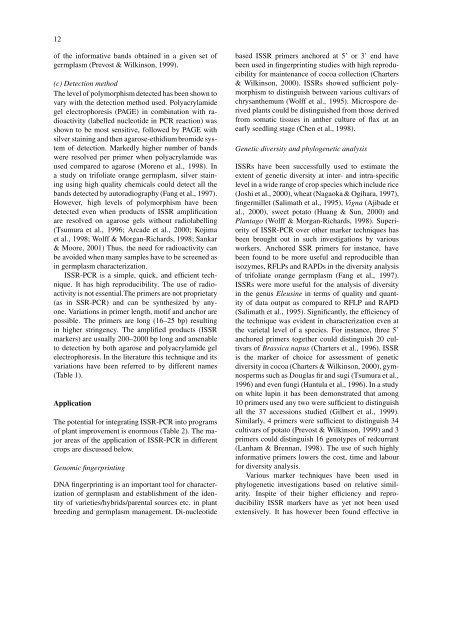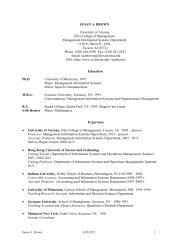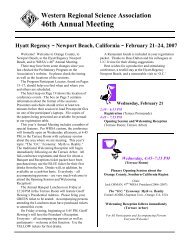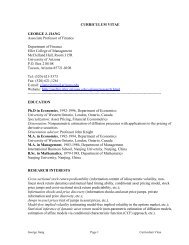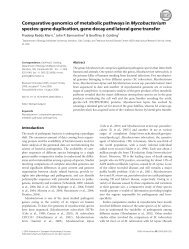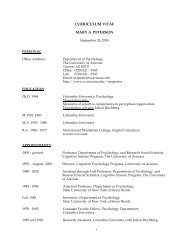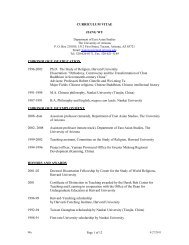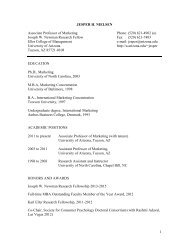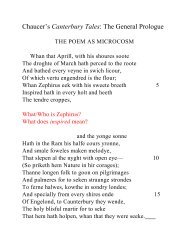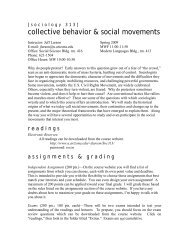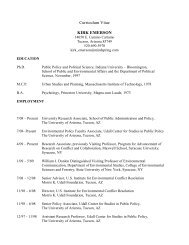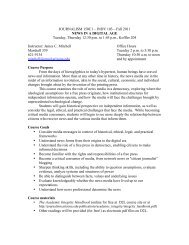Inter simple sequence repeat (ISSR) polymorphism and its ...
Inter simple sequence repeat (ISSR) polymorphism and its ...
Inter simple sequence repeat (ISSR) polymorphism and its ...
Create successful ePaper yourself
Turn your PDF publications into a flip-book with our unique Google optimized e-Paper software.
12<br />
of the informative b<strong>and</strong>s obtained in a given set of<br />
germplasm (Prevost & Wilkinson, 1999).<br />
(c) Detection method<br />
The level of <strong>polymorphism</strong> detected has been shown to<br />
vary with the detection method used. Polyacrylamide<br />
gel electrophoresis (PAGE) in combination with radioactivity<br />
(labelled nucleotide in PCR reaction) was<br />
shown to be most sensitive, followed by PAGE with<br />
silver staining <strong>and</strong> then agarose-ethidium bromide system<br />
of detection. Markedly higher number of b<strong>and</strong>s<br />
were resolved per primer when polyacrylamide was<br />
used compared to agarose (Moreno et al., 1998). In<br />
a study on trifoliate orange germplasm, silver staining<br />
using high quality chemicals could detect all the<br />
b<strong>and</strong>s detected by autoradiography (Fang et al., 1997).<br />
However, high levels of <strong>polymorphism</strong> have been<br />
detected even when products of <strong>ISSR</strong> amplification<br />
are resolved on agarose gels without radiolabelling<br />
(Tsumura et al., 1996; Arcade et al., 2000; Kojima<br />
et al., 1998; Wolff & Morgan-Richards, 1998; Sankar<br />
& Moore, 2001) Thus, the need for radioactivity can<br />
be avoided when many samples have to be screened as<br />
in germplasm characterization.<br />
<strong>ISSR</strong>-PCR is a <strong>simple</strong>, quick, <strong>and</strong> efficient technique.<br />
It has high reproducibility. The use of radioactivity<br />
is not essential.The primers are not proprietary<br />
(as in SSR-PCR) <strong>and</strong> can be synthesized by anyone.<br />
Variations in primer length, motif <strong>and</strong> anchor are<br />
possible. The primers are long (16–25 bp) resulting<br />
in higher stringency. The amplified products (<strong>ISSR</strong><br />
markers) are usually 200–2000 bp long <strong>and</strong> amenable<br />
to detection by both agarose <strong>and</strong> polyacrylamide gel<br />
electrophoresis. In the literature this technique <strong>and</strong> <strong>its</strong><br />
variations have been referred to by different names<br />
(Table 1).<br />
Application<br />
The potential for integrating <strong>ISSR</strong>-PCR into programs<br />
of plant improvement is enormous (Table 2). The major<br />
areas of the application of <strong>ISSR</strong>-PCR in different<br />
crops are discussed below.<br />
Genomic fingerprinting<br />
DNA fingerprinting is an important tool for characterization<br />
of germplasm <strong>and</strong> establishment of the identity<br />
of varieties/hybrids/parental sources etc. in plant<br />
breeding <strong>and</strong> germplasm management. Di-nucleotide<br />
based <strong>ISSR</strong> primers anchored at 5’ or 3’ end have<br />
been used in fingerprinting studies with high reproducibility<br />
for maintenance of cocoa collection (Charters<br />
& Wilkinson, 2000). <strong>ISSR</strong>s showed sufficient <strong>polymorphism</strong><br />
to distinguish between various cultivars of<br />
chrysanthemum (Wolff et al., 1995). Microspore derived<br />
plants could be distinguished from those derived<br />
from somatic tissues in anther culture of flax at an<br />
early seedling stage (Chen et al., 1998).<br />
Genetic diversity <strong>and</strong> phylogenetic analysis<br />
<strong>ISSR</strong>s have been successfully used to estimate the<br />
extent of genetic diversity at inter- <strong>and</strong> intra-specific<br />
level in a wide range of crop species which include rice<br />
(Joshi et al., 2000), wheat (Nagaoka & Ogihara, 1997),<br />
fingermillet (Salimath et al., 1995), Vigna (Ajibade et<br />
al., 2000), sweet potato (Huang & Sun, 2000) <strong>and</strong><br />
Plantago (Wolff & Morgan-Richards, 1998). Superiority<br />
of <strong>ISSR</strong>-PCR over other marker techniques has<br />
been brought out in such investigations by various<br />
workers. Anchored SSR primers for instance, have<br />
been found to be more useful <strong>and</strong> reproducible than<br />
isozymes, RFLPs <strong>and</strong> RAPDs in the diversity analysis<br />
of trifoliate orange germplasm (Fang et al., 1997).<br />
<strong>ISSR</strong>s were more useful for the analysis of diversity<br />
in the genus Eleusine in terms of quality <strong>and</strong> quantity<br />
of data output as compared to RFLP <strong>and</strong> RAPD<br />
(Salimath et al., 1995). Significantly, the efficiency of<br />
the technique was evident in characterization even at<br />
the varietal level of a species. For instance, three 5’<br />
anchored primers together could distinguish 20 cultivars<br />
of Brassica napus (Charters et al., 1996). <strong>ISSR</strong><br />
is the marker of choice for assessment of genetic<br />
diversity in cocoa (Charters & Wilkinson, 2000), gymnosperms<br />
such as Douglas fir <strong>and</strong> sugi (Tsumura et al.,<br />
1996) <strong>and</strong> even fungi (Hantula et al., 1996). In a study<br />
on white lupin it has been demonstrated that among<br />
10 primers used any two were sufficient to distinguish<br />
all the 37 accessions studied (Gilbert et al., 1999).<br />
Similarly, 4 primers were sufficient to distinguish 34<br />
cultivars of potato (Prevost & Wilkinson, 1999) <strong>and</strong> 3<br />
primers could distinguish 16 genotypes of redcurrant<br />
(Lanham & Brennan, 1998). The use of such highly<br />
informative primers lowers the cost, time <strong>and</strong> labour<br />
for diversity analysis.<br />
Various marker techniques have been used in<br />
phylogenetic investigations based on relative similarity.<br />
Inspite of their higher efficiency <strong>and</strong> reproducibility<br />
<strong>ISSR</strong> markers have as yet not been used<br />
extensively. It has however been found effective in


